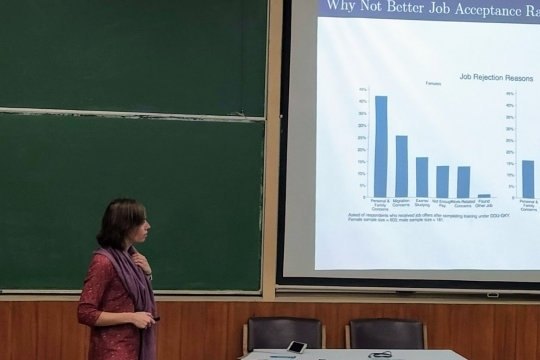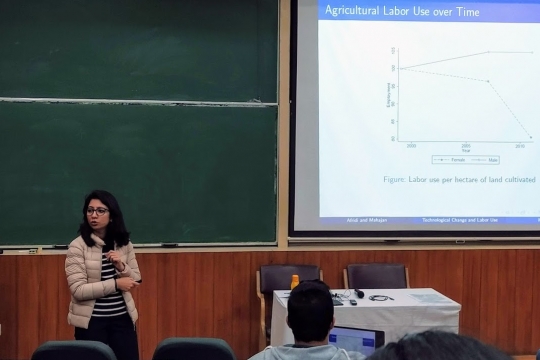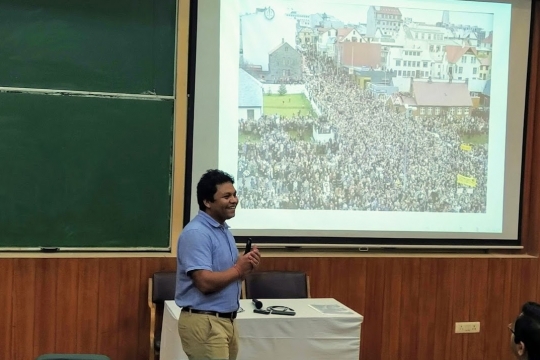Event Information
Workshop Summary :
As the world adjusts to the new reality brought on by the Covid-19 pandemic, the workspaces of the future may look very different from what they are today. How would these changes impact women? If the push towards automation is harder and faster – to reduce physical interactions at work – could there be gendered impacts of mechanisation and technological change? Which industries or occupations are likely to be affected more, and what implications or challenges do they present for skilling of women? To develop insights into how this might play out going forward, it is important to analyse the current and past experience with technological changes, skilling, and institutions in affecting women's lives.
Women’s formal engagement in the economy is often invisible in developing settings, but there are several factors that can both hinder and promote their economic and social well-being. In a recent workshop on ‘Women in the Economy’ held at the Indian Statistical Institute (ISI), Delhi (with generous support of IWWAGE), economists discussed new research that throws a more ‘gendered’ light on some of the emerging issues around work and welfare.
Technology can play an important role, as the Indian economy transitions structurally – from agriculture to manufacturing and services – and also within the domain of household production activities. How do changes in production technology affect women’s role in agriculture? Can we expect mechanisation of domestic chores to liberate women from household work, as the western experience suggests? More specifically, while households often use primitive and environmentally unsustainable technology for domestic chores, what impacts might we see from shifts towards cleaner fuels for cooking on women’s well-being and time-use?
Another set of ongoing research explores the challenges faced in skilling women to take up ‘decent’ and better-paying jobs in the formal economy. There are, however, several problems in retaining women (and men) in the skilling programmes as well as in ensuring that they continue to gainfully employ these skills beyond marriage. What strategies can be effective in achieving these goals? Can enhancing women’s skills in managing household accounts have a similar, if not greater, positive influence on own and household well-being?
Finally, we must acknowledge the significant role of institutions in affecting women’s lives. Political ideology can have long-lasting impacts on social attitudes and gender norms that affect not only women but also their children’s well-being for generations. Furthermore, empowering women politically can give voice to their demand for better provision of public goods and services. What role does the gender of the leader and of the elector play in public service delivery?
We elaborate on each of these themes and related ongoing research presented at the workshop.
Examining the role of technology through a ‘gender lens’
Kanika Mahajan (Ashoka University) presented her research1 on technological change and women’s labour in agriculture. Over time, rural employment in the farm sector has been falling on the whole but the fall has been greater for women, leading to de-feminisation of the sector. This decline in women’s participation in agriculture (from 36% in 1999 to 32% in 2011) is the biggest contributor to their overall decline in the labour force in rural India. The study analyses whether ‘push’ factors, that is, falling labour demand in the farm sector, have gender differentiated impacts. In particular, the focus is on mechanisation in the land preparation stage, which can influence labour demand directly in the particular task and also via complementarities across tasks – for example, less physical labour requirement for weeding in the next stage, but greater requirement in the following stage due to higher yield. The gender differentiated impacts are expected to come from the varying proportions of women and men involved in the different stages of agricultural production: higher physical strength is required in ploughing (upstream task) relative to weeding and harvesting (downstream tasks).
The analysis uses district-level data that is compiled from a variety of sources such as the Agricultural Input Censuses. It is found that the adoption of mechanisation in the land preparation stage leads to a reduction in labour use per hectare for both women and men as far as family labour is concerned, but the relative fall is more for females among casual labour. The results for women are driven by a fall in labour requirement in weeding.
Tarun Jain (Indian Institute of Management, Ahmedabad) discussed his work2 on the impact of women’s labour force participation on household technology adoption. The context of the study is of twentieth century United States, which saw large increases in the use of labour- and time-saving technology in households as well a rise in female labour force participation (FLFP) in the middle of the century. While this was concurrent with other social changes such as increase in female education and decline in fertility, women retained primary responsibility of household chores and childcare. In the debate on the relationship between household technology and FLFP, the dominant view is that appliances served as “engines of liberation” and freed up women’s time for leisure or the formal labour market, rather than household production. The alternate view is that American housewives discovered that they needed full-time employment and with the help of appliances such as washing machines they could undertake employment without endangering their family’s living standards.
To explore whether increase in FLFP led to increase in household technology adoption, this study exploits the exogenous increase in FLFP due to the increase in demand for workers in World War II factories, and draft that reduced the availability of male workers. It is found that 1 standard deviation (S.D.) increase in FLFP leads to 0.5 S.D. increase in washing machine adoption. The research finds support for the ‘income channel’ in driving this relationship: working women have both the incentive as well as means to purchase labour-saving appliances. It is also seen that as the availability of domestic workers reduced, they were substituted with appliances such as washing machines.
Sisir Debnath (Indian Institute of Technology, Delhi) presented research3 on household production, technology, and women’s time allocation in rural India. Women disproportionately bear the burden of unpaid domestic chores, limiting their participation in the labour market. In view of the declining FLFP in rural India, this study explores the hypothesis that lack of access to efficient and clean fuel may contribute towards this trend and lower women’s psychosocial well-being. It is based in Indore district of the state of Madhya Pradesh, involving 3,000 households across 150 randomly sampled villages. A baseline survey was undertaken to understand women’s time use and the impact of LPG (liquefied petroleum gas) on their time allocation and psychosocial well-being. This was followed by a cluster-randomised controlled trial (RCT) wherein randomly selected villages were assigned to receive information on the health and financial benefits of LPG.
It is seen that providing information on the health benefits of LPG and available subsidies can induce households to choose a cleaner and more efficient home production technology. Having an LPG connection reduces time spent by women on household chores (cooking and possibly fuel collection). In households that are poorer, LPG usage releases more time for income-generating work (paid or unpaid) by women. In better-off households, regular use of LPG may raise leisure time of women. Hence, preliminary findings suggest that more efficient home production technologies can improve women’s welfare.
To summarise, technology can be both an enabler – reducing women's time on domestic chores and freeing them for either remunerative work or leisure – but it can also displace women from work if their involvement is in the less-skilled tasks of production.
Engendering institutions
Bipasha Maity (Ashoka University) presented her research on the impact of early exposure to gender-based discriminatory institutions on later life outcomes in Afghanistan. The context is the Taliban regime under which there was prohibition on women seeking education and employment, going out without a male relative, and so on, and strict punishment on non-compliance. The study compares outcomes for children born during Taliban rule with those born before, and with those under Massoud’s leadership in Northern Alliance provinces. Correspondingly, these comparisons are undertaken for adult women and men who were adolescents during the Taliban regime.
Based on analysis of data from the Afghanistan Demographic and Health Surveys (AfDHS), 2015, it is found that: (i) Mortality is higher among children exposed to Taliban administration; however, this trend is mostly driven by male children (ii) Greater justification of wife-beating under various circumstances and higher likelihood of experiencing some forms of spousal violence among women who were adolescents at that time (iii) While men’s attitude towards wife-beating remains unaltered overall, when compared with Massoud’s provinces justification of wife-beating is higher among men exposed to Taliban rule as adolescents. (iv) Female labour force participation (FLFP) is lower among women exposed to Taliban rule as adolescents. (v) The gap between Taliban and Northern Alliance provinces appears to be falling in terms of age at marriage and first birth.
Hence, the study establishes the importance of institutions in shaping gender attitudes and how restrictions of rights and mobility of women can also have detrimental effects on the survival of children.
Sugat Chaturvedi (ISI, Delhi Centre) presented his research4 that analyses the role of voter versus leader preference in driving the gender quota effect in politics. Gender quotas are used to improve women’s political representation; the evidence on how this might affect public good provision is mixed. In terms of the ‘supply’ of public goods, female and male leaders may have different preferences, and on the ‘demand’ side, there is a possibility of differential responsiveness to voter demand or differential demand by voters based on the gender of the leader. The researchers explore this question in the context of Gram Panchayat elections in the state of Uttar Pradesh in 2015, and toilet construction under Swachh Bharat Mission. The analysis exploits the established fact that women have a greater preference for toilets, and that the gender gap in preferences is smaller among Hindus than Muslims.
It is seen that supply preferences seem to matter, while the demand side does not play a significant role. Hence, supply preferences of women leaders who come through reservation is a prerequisite for public good provision, and if the gender gap in preferences is not large enough gender reservation may not improve public good provision.
On the one hand, institutions can be affected rapidly through political change and have enduring effects on women's well-being and on the other hand, women’s role in institutions can influence societal well-being.
Skilling women
Dropout during training or lack of retention in placement jobs is a key concern for Deen Dayal Upadhyaya Grameen Kaushalya Yojana (DDU-GKY), a skill training-cum-placement programme of the Government of India that was launched in 2014 and focuses on rural youth and school drop-outs. In the context of DDU-GKY, Charity Troyer Moore (Yale University) presented a study5 from Odisha, exploring the question: Can skilling draw young, unmarried women into the labour force? As per the Socio-Economic Caste Census (SECC) 2011, of 41.8 million females in the 15-29 age group in the state, 2.7 million are unmarried women that are idle – they are neither working nor in school. One rationale for focusing on this group is that when women are provided with economic opportunities they are more likely to continue on to higher education, and delay marriage and childbearing.
The study involves a phone survey of 2,610 former DDU-GKY trainees across seven states including Odisha, 80% of whom were unmarried at the time of training. The focus is on post-training experience and job outcomes. Women are found to be less likely to receive job offers but also less likely to accept job offers – especially when they require migration – and to retain jobs. A lot of this has to do with personal and family concerns. Further, the study looks at a policy innovation in Odisha that involves mobilising Self-Help Group (SHG) cadre members to recruit and retain trainees. While this led to overall growth in numbers and completion rates in skilling over time, it was not more effective than status quo at recruiting women to training. The analysis concludes that the opportunity to pull unmarried, idle women into the labour force is high. Constraints related to both screening and household optimisation are important for young women, and SHG recruiters alone have not yet solved these.
Bhaskar Chakravorty (University of Warwick) gave an overview of another ongoing study6 related to DDU-GKY on whether information about job prospects reduces dropout from training programmes. The study hypotheses that probable reasons for this are: (i) lack of information leads to a mismatch between trainee’s expectations versus what the programme offers (ii) lack of job readiness of the candidates and household members in case placements are outside the residence state. This is being tested by implementing information sessions randomly across 90 training batches under DDU-GKY in the states of Bihar and Jharkhand.
Switching gears to financial literacy, Asad Islam (Monash University) discussed his study7 on rural women in Bangladesh on the effectiveness of maintaining a financial diary in improving money management behaviour. The study experiments with two types of alternative financial interventions in addition to traditional financial education: (i) Financial diary, which is less intensive and lower cost, but time consuming; and (ii) financial counselling, which is intensive and tailored to a special need, but costly. An RCT is conducted among 150 villages in the districts of Khulna and Satkhira, involving women in the 20-45 age group. It is found that maintaining a financial diary has a similar impact to traditional financial education in improving money management behaviour; it is also as efficient in improving downstream behaviour such as borrowing, and using formal/semi-formal financial services. However, counselling does not seem to contribute to any extra gains in knowledge.
Both financial education and diaries reduce participants’ proclivity to save, but they may increase expenditure to take advantage of investment opportunities. There is a strong impact of the traditional classroom on women’s decision-making power and self-evaluated confidence, while diaries are especially effective in enhancing household bargaining power.
Overall, skilling seems to have several issues of take-up and retention and may not always lead to enduring effects on women’s employment. Ongoing research highlights the need to tailor the skilling programmes towards the specific constraints faced by women. However, when we enhance skills that women can use at home then there are some clear, long-term benefits.




